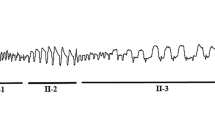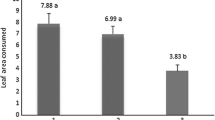Abstract
Effects of soybean phytoalexins on the feeding of the soybean looper and Mexican bean beetle were investigated to test the hypothesis that phytoalexins might be a defense mechanism of plants against insects as well as against pathogens. Short-term behavioral responses to the phytoalexins were analyzed using dual-choice tests with phytoalexin-rich and phytoalexin-poor (control) tissues. Phytoalexin production was elicited with ultraviolet radiation. Results from the dual-choice tests indicated that 6th instar soybean looper larvae fed equally on the control and phytoalexin-rich tissues. Feeding by adult and 4th instar Mexican bean beetles, however, was strongly deterred by the phytoalexins as evidenced by “single-bite” mandible scars on the phytoalexin-rich cotyledon discs. Nutritional effects of the isoflavonoid phytoalexin glyceollin on early instar soybean looper larvae were tested by incorporating the phytoalexin into an artificial medium at a level of 1% dry weight (0.15% fresh weight). The larvae were reared for 7 days from emergence on diets of control and glyceollin-containing media. Although survival on the glyceollin diets was initially less than on the control diets, under the experimental conditions glyceollin had no significant effect on the growth, development, or subsequent survival of the larvae. Efficiency of food utilization (ECI) was reduced, indicating that the phytoalexins may be a mild digestibility-reducing factor for the loopers. Implications of the results for host-plant resistance are discussed.
Similar content being viewed by others
References
Akazawa, T., Uritani, I., andKubota, H. 1960. Isolation of ipomeamarone and two coumarin derivatives from sweet potato roots injured by the weevil,Cylas formicarius elegantulus.Arch. Biochem. Biophys. 88:150–156.
Beck, S.D. 1965. Resistance of plants to insects.Annu. Rev. Entomol 10:207–232.
Bridge, M.A., andKlarman, W.L. 1973. Soybean phytoalexin, hydroxyphaseollin, induced by ultraviolet irradiation.Phytopathology 63:606–608.
Burden, R.S., andBailey, J.A. 1975. Structure of the phytoalexin from soybean.Phytochemistry 14:1389–1390.
Burleigh, J.G. 1972. Population dynamics and biotic controls of the soybean looper in Louisiana.Environ. Entomol. 1:290–294.
Carroll, C.R., andHoffman, C.A. 1980. Chemical feeding deterrent mobilized in response to insect herbivory and counteradaptation byEpilachna tridecimnotata.Science 209:414–416.
Cruickshank, I.A.M. 1963. Phytoalexins.Annu. Rev. Phytopathol. 1:351–374.
Dethier, V.G., Barton-Browne, L., andSmith, C.N. 1960. The designation of chemicals in terms of the responses they elicit from insects.J. Econ. Entomol. 53:134–136.
Deverall, B.J. 1976. Current perspectives in research on phytoalexins, pp. 207–223,in J, Friend and D.R. Threlfall (eds.). Biochemical Aspects of Plant-Parasite Relationships. Academic press, New York.
Elliger, C.A., Chan, B.C., andWaiss, A.C., Jr. 1980. Flavonoids as larval growth inhibitors.Naturwissenschaften 67:358–360.
Frank, J.A., andPaxton, J.D. 1971. An inducer of soybean phytoalexin and its role in the resistance of soybeans toPhytophthora rot.Phytopathology 8:954–958.
Fukami, H., andNakajima, M. 1971. Rotenone and the rotenoids, pp. 71–97,in M. Jacobsen and D.G. Crosby (eds.). Naturally Occurring Insecticides. Marcel Dekker, New York.
Harborne, J. 1979. Flavonoid pigments, pp. 619–655,in G.A. Rosenthal and D.H. Janzen (eds.). Herbivores: Their Interaction with Secondary Plant Metabolites. Academic Press, New York.
Hedin, P.A. (ed.). 1977. Host plant resistance to pests.Am. Chem. Soc. Symp. Ser. 62:286 pp.
Henneberry, T.J., andKishaba, A.N. 1966. Cabbage loopers, pp. 461–478,in C.N. Smith (ed.). Insect Colonization and Mass Production. Academic Press, New York.
Herzog, D.C. 1980. Sampling soybean looper on soybean, pp. 141–168,in M. Kogan and D.C. Herzog (eds.). Sampling Methods in Soybean Entomology. Springer-Verlag, New York.
Jackai, L.E.N. 1978. Induction and host-selection behavior in the soybean looper,Pseudoplusia includens, Walker (Lepidoptera: Plusiinae). PhD dissertation, University of Illinois, Urbana-Champaign.
Janzen, D.H. 1979. New Horizons in the biology of plant defenses, pp. 331–350,in G.A. Rosenthal and D.H. Janzen (eds.). Herbivores: Their Interaction with Secondary Plant Metabolites. Academic Press, New York.
Jones, C.G., andFirn, R.D. 1979. Some allelochemicals ofPteridium aquilinum and their involvement in resistance toPieris brassicae.Biochem. Syst. Ecol. 7:187–192.
Kaplan, D.T., Keen, N.T., andThomason, I.J. 1980. Studies on the mode of action of glyceollin in soybean: Incompatibility to the root knot nematode.Meliodogyne incognita. Physiol. Plant Pathol. 16:319–325.
Keen, N.T., andBruegger, B. 1977. Phytoalexins and chemicals that elicit their production in plants.Am. Chem. Soc. Symp. Ser. 62:1–26.
Keen, N.T., andKennedy, B.W. 1974. Hydroxyphaseollin and related isoflavonoids in the hypersensitive response of soybeans againstPseudomonas glycinea.Physiol. Plant Pathol. 4:173–185.
Keen, N.T., andPaxton, J.D. 1975. Coordinate production of hydroxyphaseollin and the yellow-fluorescent compound PAk in soybeans resistant toPhytophthora megasperma var.sojae. Phytopathology 65:635–637.
Keen, N.T., Sims, J.J., Erwin, D.C., Rice, E., andPartridge, J.E. 1971. 6a-Hydroxyphaseollin: An antifungal chemical induced in soybean hypocotyls byPhytophthora megasperma var.sojae. Phytophathology 61:1084–1089.
Keen, N.T., Zaki, A.I., andSims, J.J. 1972. Biosynthesis of hydroxyphaseollin and related isoflavonoids in disease-resistant soybean hypocotyls.Phytochemistry 11:1031–1039.
Klein, I., andKogan, M.1974. Analysis of food intake, utilization and growth in phytophagous insects—a computer program.Ann. Entomol. Soc. Am. 67:295–297.
Kogan, M. 1972. Feeding and nutrition of insects associated with soybeans. 2. Soybean resistance and host preference of the Mexican bean beetle,Epilachna varivestis.Ann. Entomol. Soc. Am. 65:675–683.
Kogan, M. 1977. The role of chemical factors in insect/plant relationships. Proc. XV Int. Congr. Entomol., Washington, D.C. pp. 211–227.
Kogan, M., andCope, D. 1974. Feeding and nutrition of insects associated with soybeans. 3. Food intake, utilization, and growth in the soybean looper,Pseudoplusia includens.Ann. Entomol. Soc. Am. 67:66–72.
Kogan, M., andGoeden, R.D. 1970. The host-plant range ofLema trilineata daturaphila (Coleoptera: Chrysomelidae).Ann. Entomol. Soc. Am. 63:1175–1180.
Kuc, J.A. 1972. Phytoalexins.Annu. Rev. Phytopathol. 10:207–232.
Kuc, J., Currier, W.W., andShih, M.J. 1976. Terpenoid phytoalexins, pp. 225–237,in J. Friend and D.R. Threlfall (eds.). Biochemical Aspects of Plant-Parasite Relationships. Academic Press, New York.
Levin, D.A. 1976. The chemical defenses of plants to pathogens and herbivores.Annu. Rev. Ecol. Syst. 7:121–159.
Loper, G.M. 1968. Effect of aphid infestation on coumestrol content of alfalfa varieties in aphid resistance.Crop Sci. 8: 104–106.
Lyne, R.L., andMulheirn, L.J. 1978. Minor pterocarpinoids of soybean.Tetrahedron Lett. 34: 3127–3128.
Lyne, R.L., Mulheirn, L.J., andLeworthy, D.P. 1976. New pterocarpinoid phytoalexins of soybean.J. Chem. Soc. Chem. Commun. 1976:497–498.
Mabry, T.J., andUlubelen, A. 1980. Chemistry and utilization of phenylpropanoids including flavonoids, coumarins, and lignans.J. Agric. Food Chem. 28:188–196.
McIntyre, J.L., Kodds, J.A., andHare, J.D. 1981. Effects of localized infections ofNicotiana tabacum by tobacco mosaic virus on systemic resistance against diverse pathogens and an insect.Phytopathology 71: 297–301.
Mitchell, E.R. 1967. Life history ofPseudoplusia includens (Walker) (Lepidoptera: Noctuidae).J. Ga. Entomol. Soc. 2:53–57.
Mittler, T.E. 1971. Dietary amino acid requirements of the aphidMyzus per sic ae affected by antibiotic uptake.J. Nutr. 101:1023–1028.
Moesta, P., andGrisebach, H. 1980. Effects of biotic and abiotic elicitors on phytoalexin metabolism in soybean.Nature 286:710–711.
Paxton, J.D. 1980. A new working definition of the term ‘Phytoalexin.’Plant Dis. 64:734.
Rich, J.R., Keen, N.T., andThomason, I.J. 1977. Association of coumestans with the hypersensitivity of lima bean roots toPratylenchus scribneri.Physiol. Plant Pathol. 10:105–116.
Rosenthal, G.A., andJanzen, D.H. (eds.). 1979. Herbivores: Their Interaction with Secondary Plant Metabolites. Academic Press, New York.
Russell, G.B., Sutherland, O.R.W., Hutchins, R.F.N., andChristmas, P.E. 1978. Vestitol: A phytoalexin with insect feeding-deterrent activity.J. Chem. Ecol. 4:571–579.
Ryan, C.A. 1978. Proteinase inhibitors in plant leaves: A biochemical model for pest-induced natural plant protection.Trends Biochem. Sci. 3:148–150.
Ryan, C.A., andGreen, T.R. 1974. Proteinase inhibitors in natural plant protection.Recent Adv. Phytochem. 8:123–140.
Schoonhoven, L.M. 1981. Chemical mediators between plants and phytophagous insects, pp. 31–50,in D.A. Nordlund (ed.). Semiochemicals: Their Role in Pest Control. John Wiley & Sons, New York.
Scriber, J.M., andSlansky, F., Jr. 1981. The nutritional ecology of immature insects.Annu. Rev. Entomol. 26:183–211.
Shaver, T.N., andLukefahr, M.J. 1969. Effect of flavonoid pigments and gossypol on growth and development of the bollworm, tobacco budworm, and pink bollworm.J. Econ. Entomol. 62:643–646.
Shirata, A. 1978. Production of phytoalexin in cortex tissue of mulberry shoot.Ann. Phytopathol. Soc. Jpn. 44:485–492.
Sutherland, O.R.W., Russell, G.B., Biggs, D.R., andLane, G.A. 1980. Insect feeding deterrent activity of phytoalexin isoflavonoids.Biochem. Syst. Ecol. 8:73–75.
Swain, T. 1977. Secondary compounds as protective agents.Annu. Rev. Plant Physiol. 28: 479–501.
Todd, G.W., Getahun, A., andCress, D. 1971. Resistance in barley to the greenbug,Schizaphis graminum. 1. Toxicity of phenolic and flavonoid compounds and related substances.Ann. Entomol. Soc. Am. 64:718–722.
Turnipseed, S.G., andShepard, M. 1980. Sampling Mexican bean beetle on soybean, pp. 189–200,in M. Kogan and D.C. Herzog (eds.). Sampling Methods in Soybean Entomology. Springer-Verlag, New York.
Uritani, I., Saito, T., Honda, H., andKim, W.K. 1975. Induction of furanoterpenoids in sweet potato roots by the larval components of the sweet potato weevil.Agric. Biol. Chem. 39:1857–1862.
Van Etten, H.D., andPueppke, S.G. 1976. Isoflavonoid phytoalexins, pp. 239–289,in J. Friend and D.R. Threlfall (eds.). Biochemical Aspects of Plant-Parasite Relationships. Academic Press, New York.
Waldbauer, G.P. 1968. The consumption and utilization of food by insects.Adv. Insect Physiol. 5:229–288.
Weinstein, L.I., Hahn, M.G., andAlbersheim, P.A. 1981. Host-pathogen interactions. XVIII. Isolation and biological activity of glycinol, a pterocarpan phytoalexin synthesized by soybeans.Plant Physiol. 68:358–363.
Whittaker, R.H., andFeeny, P. 1971. Allelochemics: Chemical interactions between species.Science 171:757–770.
Yoshikawa, M., Yamauchi, K., andMasago, H. 1978. Glyceollin: Its role in restricting fungal growth in resistant soybean hypocotyls infected withPhytophthora megasperma var.sojae. Physiol. Plant Pathol. 12:73–82.
Author information
Authors and Affiliations
Additional information
Mexican bean beetle=Epilachna varivestis Mulsant, (Coleoptera: Coccinellidae); soybean looper=Pseudoplusia includens (Walker), (Lepidoptera: Noctuidae).
This publication is a contribution of the State Natural History Survey and Illinois Agricultural Experiment Station, College of Agriculture, University of Illinois at Urbana-Champaign. Research was supported in part by the USDA competitive grant 800235 “Role of phytoalexins in soybean resistance to insects,” the State Agricultural Experiment Station Regional project S-74 (IL 120320), and the US-EPA through a grant, CR-806277-02-0, to Texas A & M University. The opinions expressed herein are those of the authors and not necessarily those of the supporting institutions or agencies.
Rights and permissions
About this article
Cite this article
Hart, S.V., Kogan, M. & Paxton, J.D. Effect of soybean phytoalexins on the herbivorous insects mexican bean beetle and soybean looper. J Chem Ecol 9, 657–672 (1983). https://doi.org/10.1007/BF00988774
Received:
Revised:
Issue Date:
DOI: https://doi.org/10.1007/BF00988774




